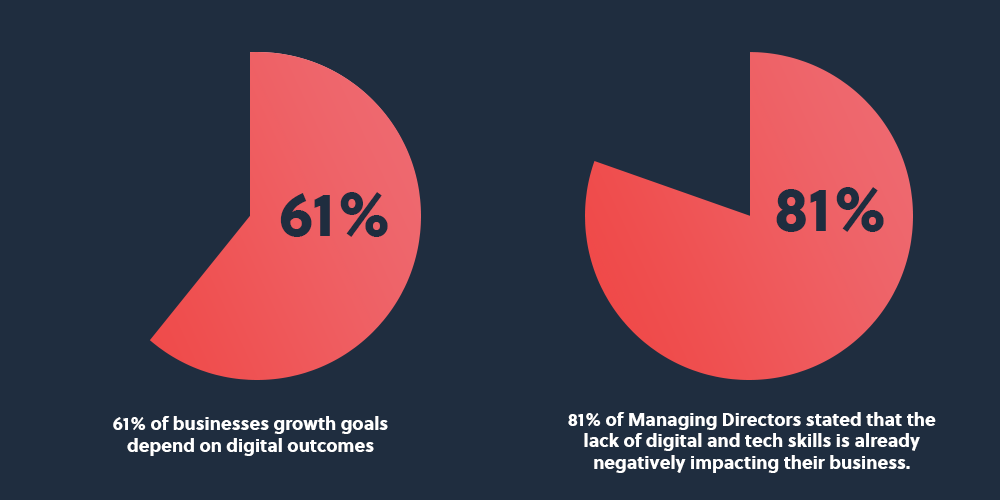Undeniably, the UK Tech industry currently faces a skills gap, presenting an ongoing issue for businesses looking to accelerate their growth and innovation.
The gap between the skills professionals possess and those that businesses require is wreaking havoc on the ability of tech businesses to hire, and there’s a growing bank of research to back this up: techUK’s recent Digital Economy Monitor revealed that 57% of UK IT firms find the present talent shortage and access to skills among the biggest barrier for their companies (Tech Monitor); equally, AND Digital’s ‘Nature of the UK’s Digital Skills Gap’ Report revealed that 61% of businesses growth goals depend on digital outcomes, and 81% of Managing Directors stated that the lack of digital and tech skills is already negatively impacting their business.
And it’s not just businesses themselves that are feeling the impact of this: the same report also found that 22% of employees surveyed felt that their lack of digital skills was impacting their ability to progress in their roles, and 58% said they had never received any formal digital training from their employers.

So, what can be done to resolve this?
Early Education & The Digital Divide
In the long term, the resolution must start with early education. The focus should be on building a pipeline of talent to safeguard the future of the industry. A great recent example of this is an initiative that has just been launched by WPP called ‘The Creative Data School’, which offers over 6,000 10 to 25-year-olds across the UK the opportunity to learn essential technical skills and build their confidence in Data and AI.
However, the adoption of digital skills into the national curriculum needs to be on the government’s education agenda: digital is the future; the prevalence of tech in our daily lives and its vitality to business operations is a testament to this. To this end, the UK Digital Strategy, published in October 2022, outlined the government’s ongoing approach to prioritising the Digital industry. The report announced some positive steps in the right direction: for example, by introducing coding into the primary curriculum, and ensuring that the DfE must equip every school in England with ‘the knowledge to teach computing and ensure that children have the digital skills they need to participate in a digital society.’ Equally important to the future and growth of the industry is addressing the digital divide for families who don’t have access to tech, to ensure we aren’t excluding young minds from future opportunities in the industry.
Upskilling
For those who are already embedded within the industry, but whose digital skills are falling behind where they need to be, it could be argued that businesses have a duty to upskill them and provide training to try and close these gaps. It is in the best interest of these businesses to do so. CIPD’s Resourcing and Talent Planning Survey found that ‘nearly two-fifths of organisations (38%) are increasing efforts to meet their talent requirements by developing more talent in-house’, and ‘upskilling existing employees is the most common response to recruitment difficulties (60%).’
But, whilst it is certainly in the best interest of businesses to upskill their existing staff, a lack of budget, time, and resources often provides a stumbling block to do this, particularly in times of economic turbulence.
What is the short-term solution for businesses?
As crucial as building a skills pipeline for the future is, none of the methods outlined above can help businesses in the short term. With skilled talent becoming harder to find, the competition to secure them has become fierce; the CIPD’s survey also found that the competition for well-qualified talent has increased by 70% in the last year, with 81% of organisations attempting to fill vacancies and 77% of these experiencing difficulties attracting candidates to them (up from 49% from the same survey in 2021).
Resolving the gap in the long term is a necessary pursuit, but when growth is being stunted for the tech industry in the here and now, businesses need to find a stopgap. If, for example, your average hiring time was once 2 weeks, and this has now increased to 6 weeks as a result of the increasingly competitive hiring market, this is already a significant period of time to be without the staff you need. Add into the mix a counteroffer, which we have seen a huge increase in of late, then you may end up back at square one, and it could be 12 weeks before you actually secure the talent you need. We have seen clients in our industry holding out for months to try and find the right individual to join their business. But, in the meantime, the knock-on effect is massive. Projects are pushed back, growth is stunted, and revenue is lost.
Explore an interim workforce
An ideal resolution would be to utilise a digital contractor to plug the gap for the duration of the process. Whilst many businesses and hiring managers will dismiss the idea of using contractors to keep projects afloat whilst a permanent employee can be found, it’s advisable to consider what the cost to the business is in the long term whilst work is put on hold, versus the cost of employing a temporary professional. Equally, the full ongoing costs of a permanent employee, such as holiday, pension, sick pay, and taxes, are often not taken into consideration. Contractors can offer a highly profitable short-term investment, as they are highly-skilled individuals who are able to turn projects around quickly and at a high level.
Moreover, a key motivator for utilising an interim workforce in times of financial uncertainty is the lack of risk involved; utilising contractors buys businesses time to find the right fit with the right skill set, without ongoing projects and business revenue suffering. Contractors can be relinquished at short notice, where a permanent employee will have to be made redundant as and when priorities change.